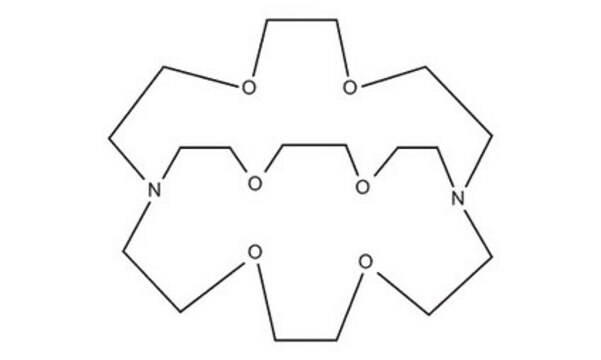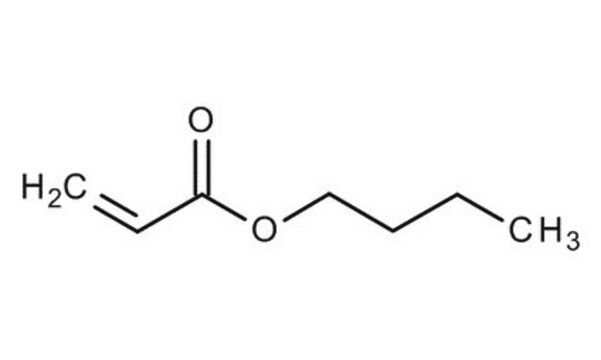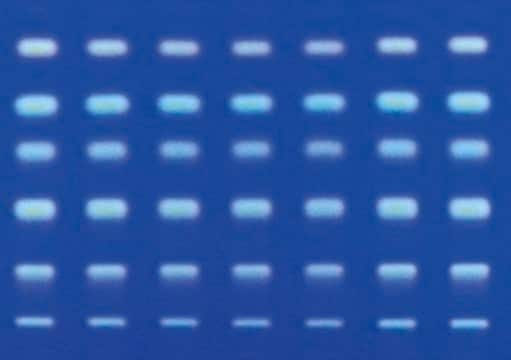8.14925
Kryptofix® 222
special quality for synthesis
Sinônimo(s):
Kryptofix® 222, 4,7,13,16,21,24-Hexaoxa-1,10-diazabicyclo[8.8.8]hexacosane
About This Item
Produtos recomendados
Nível de qualidade
potência
300-2000 mg/kg LD50, oral (Rat)
pf
70-73 °C
temperatura de armazenamento
2-8°C
InChI
1S/C18H36N2O6/c1-7-21-13-14-24-10-4-20-5-11-25-17-15-22-8-2-19(1)3-9-23-16-18-26-12-6-20/h1-18H2
chave InChI
AUFVJZSDSXXFOI-UHFFFAOYSA-N
Aplicação
- Improved, one-pot synthesis of 6-[(18) F]fluorodopamine and quality control testing for use in patients with neuroblastoma.: This study presents an improved method for synthesizing 6-[(18) F]fluorodopamine using Kryptofix 222. The one-pot synthesis process enhances efficiency and quality control, making it suitable for clinical applications in neuroblastoma patients (Vāvere et al., 2018).
- Efficient radiosynthesis and non-clinical safety tests of the TSPO radioprobe [(18)F]FEDAC: Prerequisites for clinical application.: Kryptofix 222 is utilized in the radiosynthesis of [(18)F]FEDAC, a radioprobe for TSPO imaging. The study highlights the efficiency and safety of the synthesis process, facilitated by Kryptofix 222, and its potential for clinical application (Kawamura et al., 2016).
- Fully automated one-pot radiosynthesis of O-(2-[18F]fluoroethyl)-L-tyrosine on the TracerLab FX(FN) module.: This research demonstrates the automated synthesis of O-(2-[18F]fluoroethyl)-L-tyrosine, employing Kryptofix 222 as a phase transfer catalyst. The automated process significantly improves the synthesis efficiency (Bourdier et al., 2011).
- Electrochemical concentration of no-carrier-added [(18)F]fluoride from [(18)O]water in a disposable microfluidic cell for radiosynthesis of (18)F-labeled radiopharmaceuticals.: Kryptofix 222 plays a crucial role in the electrochemical concentration of [(18)F]fluoride, facilitating the radiosynthesis of various (18)F-labeled radiopharmaceuticals in a microfluidic cell, enhancing the overall efficiency and yield (Saiki et al., 2010).
Nota de análise
Purity (GC): ≥ 99
Identity (IR-spectrum): passes test
Melting point: 69 - 72
Biggest singly impurity (GC): ≤ 0.1 %
Acetone (HS-GC): ≤ 5000 ppm
Acetonitrile (HS-GC): ≤ 410 ppm
Dichloromethane (HS-GC): ≤ 600 ppm
n-Hexane (HS-GC): ≤ 290 ppm
Methanol (HS-GC): ≤ 3000 ppm
petroleum ether (HS-GC): ≤ 290 ppm
Pyridine (HS-GC): ≤ 200 ppm
Sulfated ash: ≤ 0.1 %
Water (according to Karl Fischer): ≤ 0.5
E.coli: passes test
Salmonella species: passes test
Staphylococcus aureus: passes test
Pseudomonas aeruginosa: passes test
Colony count (aerobic bacteria): ≤ 5000 CFU/g
Colony count (Yeasts and moulds): ≤ 500 CFU/g
Endotoxins: ≤ 50 I.U./g
Informações legais
Palavra indicadora
Danger
Frases de perigo
Declarações de precaução
Classificações de perigo
Acute Tox. 4 Oral - Eye Dam. 1 - Skin Irrit. 2
Código de classe de armazenamento
11 - Combustible Solids
Classe de risco de água (WGK)
WGK 3
Certificados de análise (COA)
Busque Certificados de análise (COA) digitando o Número do Lote do produto. Os números de lote e remessa podem ser encontrados no rótulo de um produto após a palavra “Lot” ou “Batch”.
Já possui este produto?
Encontre a documentação dos produtos que você adquiriu recentemente na biblioteca de documentos.
Os clientes também visualizaram
Nossa equipe de cientistas tem experiência em todas as áreas de pesquisa, incluindo Life Sciences, ciência de materiais, síntese química, cromatografia, química analítica e muitas outras.
Entre em contato com a assistência técnica
![4,7,13,16,21,24-Hexaoxa-1,10-diazabicyclo[8.8.8]hexacosane 98%](/deepweb/assets/sigmaaldrich/product/structures/189/812/8a6555e5-8de6-4236-865f-19339cee3634/640/8a6555e5-8de6-4236-865f-19339cee3634.png)









